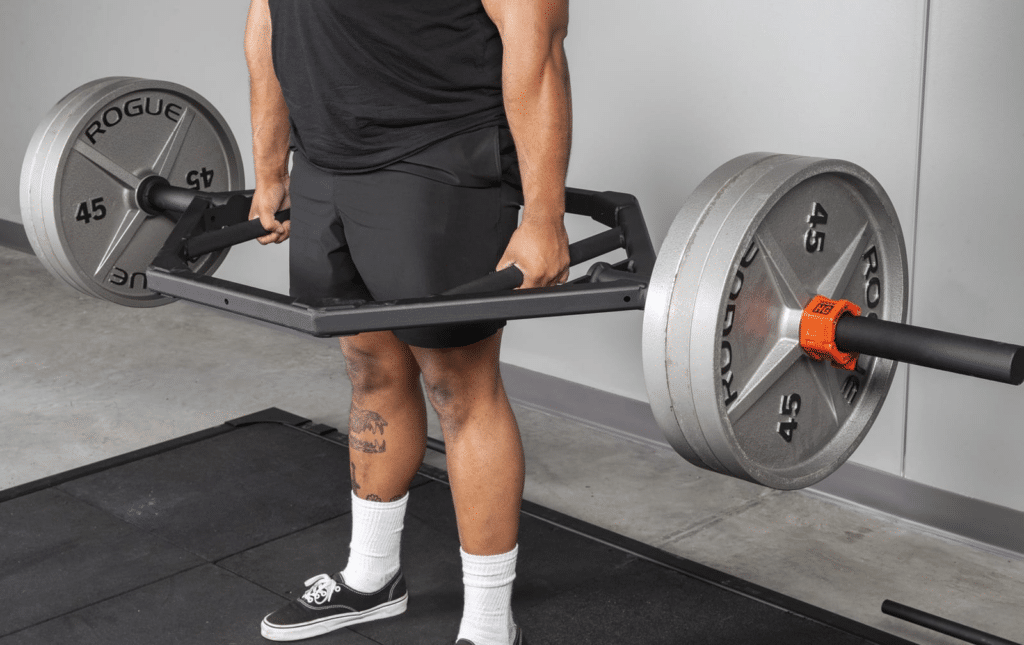Traditional barbell deadlifts have ruled the fitness world for a long time, and with reason. They are easy to learn and offer a large variety of benefits.
This article will cover the hex bar deadlift form and technique and how to master them. You’ll learn a hex bar and how to do a deadlift with it.
We’ll cover a step-by-step guide to teach you how to do hex bar deadlifts while avoiding common mistakes and injury risks.
Here’s a glimpse of what you’ll learn:
– What is a Hex Bar?
– How to do a Hex Bar Deadlift
– Common mistakes and how to avoid them.
Let’s dive in!
Jump to:
Hex Bar: What it is and How it works
The hex bar, also called the “Trap bar,” is a hexagonal barbell that allows you to step in and keep your center of gravity closer to the bar.
The trap bar has two handle settings, high and low handles. Both options typically require a neutral grip.
This bar will put your body in an advantageous position with a more upright torso than a straight barbell and traditional deadlifts.
Another difference is that this variation will target your quads more because the starting position has more knee flexion and less hip hinge.
The hex bar deadlift is commonly used for athletic performance and developing peak power and velocity while minimizing injury risk.

How To Do a Hex Bar Deadlift
Contrary to regular deadlifts, the hex bar deadlift is easier to learn. It requires less joint mobility and range of motion.
Those characteristics make them ideal for sports athletes, beginners, people with recurrent back injuries, and the elderly.
If you want to master a hex bar deadlift, follow these five steps and keep injuries at bay!
Step 1: Load the hex bar
An empty hex bar is usually 45 pounds. If that’s too light for you, add enough weight to keep the movement challenging while prioritizing the technique.
You’ll find that you can lift heavier weights faster with the hex bar. This is due to your body being in a more favorable position.
Step 2: Stand in the hex bar
The hexagonal-shaped bar allows you to step in it and remain at the center of gravity during the movement.
Make sure to place your feet at hip-width before descending to hold the bar.
Step 3: Descend to hold the bar
Once inside the bar, hinge at your hips and squat down to hold the bar with a neutral grip. You can use the low or high handle position.
The correct starting position will have you with a neutral spine and neck and your entire body locked in before the lift.
Step 4: Breath and brace
Once your body is set, take a deep breath into your belly (diaphragm) and brace your core muscles and posterior chain.
This will help protect your spine and move heavier weights while keeping a pure hex bar deadlift form.
Step 5: Stand up
Keeping that braced position and a neutral spine and neck, stand up by extending your hips and knees at the top.
The trap bar allows a more vertical trajectory than conventional and even sumo deadlifts.
Once you’re at the top, squeeze your glutes and avoid hyperextending your lumbar spine.

How to Work out Safely and Avoid Injury
The trap bar deadlift is slightly easier to master than other deadlift variations. Still, it doesn’t mean it’s completely exempt from injury risk.
There’s always room for technical errors that can sideline you for some time, even if you’re an experienced lifter.
Next, you’ll find some of the most common mistakes and how to avoid them.
Rounded Back
A rounded back, also called “turtle back,” is one of the most prevalent form mistakes we see.
It happens when the lifter is not properly engaging the core and back muscles (lats, trapezius, and spinal erectors) to hold the spine in a neutral position throughout the movement.
In some scenarios, it can be due to muscle weakness or poor mind-muscle connection. However, this is not always bad.
It’s normal to observe a slightly rounded back in some lifters attempting maximal reps or during powerlifting competitions. The key here is not to let it compromise your spine health.
To prevent this, bring your shoulder blades back together, and brace your core by breathing into your diaphragm.

Looking Up
Looking up while deadlifting can put your neck through serious strain that could increase injury risk. Ideally, you want to hold your spine and neck in a neutral position during the movement.
It is essential to consider the body as one unit that moves altogether. The more tension there is, the more force we can produce.
One way to correct this is to think of your neck as an extension of your torso. Where your torso goes, your neck follows.
Not Bracing The Core
Not bracing the core before the lift begins may threaten your deadlift form and spine health.
Activating the core muscles before the lift will help keep a neutral spine throughout the movement. Not doing this could expose your lower back to high forces that may increase injury risk.
Learning how to breathe into your diaphragm is vital to preserve lumbar stability and secure a proper form.
Knees Caving In
The knees caving in is another typical mistake seen not only in the trap bar deadlift but in other lifting movements like the squat, jumping, and different deadlift variations.
Although this is not inherently bad or wrong, it could represent a “power leak.” When the knees cave in during the deadlift exercise, it could mean poor glute activation, therefore, less hip extension.
The hip muscles are not only responsible for extending the hip but also for externally rotating the femur. This combination creates more tension that could make lifting the bar easier.
FAQ
How To Do A Trap Bar Deadlift Properly?
Load the bar with weight plates. Hold the handles with an overhand grip and lift the bar upwards until the hips and knees are fully extended. For the starting position, hinge your hips and adopt a squat position keeping your torso upright and a neutral lumbar spine.
Where Do You Stand For A Trap Bar Deadlift?
For a trap bar deadlift, you stand inside the bar with the feet at hip-width, hip hinge, neutral neck, and spine.
Why Is A Trap Bar Easier?
The trap bar deadlift is easier for two reasons. 1) The bar stays closer to you throughout the movement, meaning there’s less resistance. 2) The bar has a less vertical distance to travel, and less range of motion is needed.















